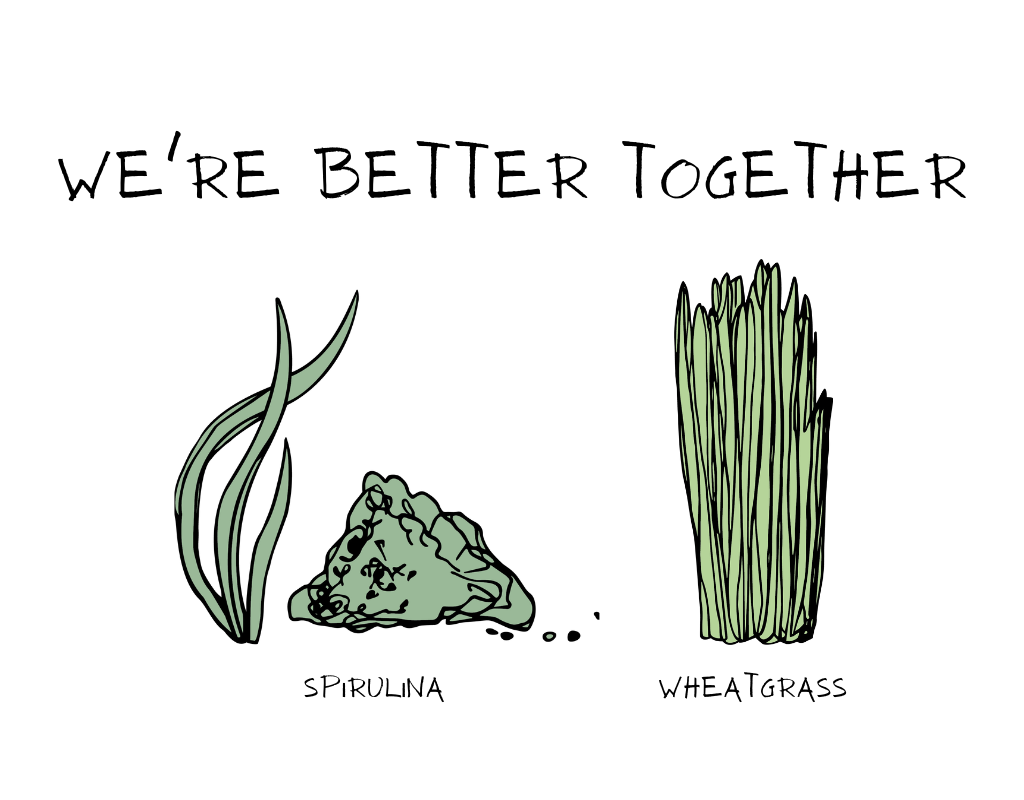Spirulina and wheatgrass go together like rama lama lama ka dinga da dinga dong. They’re kind of like soulmates––a perfect match.
The reason they’re just so good together is because wheatgrass contains high levels of chlorella, and chlorella pairs really, really nicely with spirulina.
“Spirulina, when taken with chlorella, is an ideal detox for the liver,” says Integrative Nutrition Consultant Heather Fowler. “In conjunction with chlorella, it has been known to lower estrogen dominance symptoms, as well as help improve insulin resistance, bloating, and PMS cramping.”
Working in conjunction, spirulina and wheatgrass seem to have super powers, but they’re also astoundingly powerful on their own.
Curious why these superfoods are just so super and how to incorporate them into your wellness routine? We reached out the experts for everything you need to know about spirulina and wheatgrass. Here’s what they said:
1. Spirulina can remove toxins from your blood.
One of the most powerful benefits of spirulina is how it binds with heavy metals and removes toxins from the blood, as well as boosts the immune system through high levels of Chlorophyll.
When I started supplementing with it, I noticed a difference in my energy, and it cleared up and reduced irritation in my skin immediately.
Because I love spirulina so much, I whip it into a smoothie daily. Here’s my go-to recipe:
Ingredients
1/2 cup organic blueberries
1 Tbsp. spirulina powder (start with 1/2 Tbsp. and gradually add more)
1/2 organic banana
1/2 Tbsp. fresh ginger
Approx 1 cup almond milk or water
Dash of cinnamon
Instructions
Blend together, and enjoy!
Certified Nutritionist Rebecca O'Brien
@wellnessbyrebecca
2. Spirulina is often referred to as one of the most nutrient-dense foods on Earth.
Research shows that spirulina contains significant amounts of several nutrients (even more than a multivitamin), including calcium, some B vitamins, potassium, and iron. It's also very high in protein. Approximately 70% of spirulina's dry weight is protein.
Plant-based protein has numerous health benefits, including a lower risk of heart disease. Additionally, spirulina does not contain cellulose walls and is easily digested.
Adding spirulina to your daily diet is a great way to get in more nutrition. You can take it in powder, capsule, juice shot, or tea form. It can also be added to smoothies and baked goods.
Heather Hanks, Nutritionist
3. Spirulina is a single storehouse of minerals that can be extremely valuable for your overall health.
Spirulina is a blue-green algae that is considered to be one of the oldest microorganisms on Earth, and its primitive origin makes it highly valuable for your health.
Spirulina is considered a super-food, because it’s a good source of vitamin B1,vitamin B2, vitamin B3, copper, iron, and magnesium. The regular intake of these minerals is required by your organs for proper functioning.
It is also believed that spirulina has many other overall well-being health benefits, such as increasing metabolism, preventing heart diseases, improving mental health, and maintaining a healthy weight.

Amber O'Brien, Dietician, Mango Clinic
@mangoclinic
4. The most remarkable properties of spirulina are its antioxidant and anti-inflammatory effects.
Spirulina gets this property from “phycocyanin,” a pigment-protein complex, which gives spirulina its signature blue-green hue.
Phycocyanin is not only a great antioxidant but also helps in reducing inflammation by inhibiting the pro-inflammatory agents in the body
Suman Chatterji, Founder, Good Health Corner
Wheatgrass contains a considerable amount of fiber and B vitamins, which help the digestive system's muscles function better. In fact, it can be used as an all-natural alternative to taking antacids to alleviate heartburn and indigestion.
In general, B complex vitamins aid in the transport of energy from food into tissue cells, where it is needed. Wheatgrass contains both thiamine and riboflavin, which help convert carbohydrates into energy and keep the mucosal lining of your digestive tract healthy.

Kieran Knight, Fitness Trainer & Blog Editor, Fitness Home HQ
Wheatgrass has been linked to cancer prevention thanks to its blood oxygenating ability (cancer typically thrives in a low-oxygen environment), as well as its high contents of vitamins, minerals and enzymes. Wheatgrass also contains an abundant amount of chlorophyll, which fuels the body with oxygen, thanks to its ability to increase red blood cell health.
Therese Forton-Barnes, Health Coach, The Green Living Gurus
@Greenlivingguru
Wheatgrass is an antioxidant with a remarkable capacity to negate free radicals, like Reactive Oxygen Species (ROS). This has cascading positive effects on brain health, including reducing oxidative stress, reducing cell and neuronal death, and improving cognitive functions.
Due to this neuroprotective and cognition-enhancing property, wheatgrass is now researched for its application in Alzheimer’s Disease.
Suman Chatterji, Founder, Good Health Corner
KOR makes it easy to harness the power of both of these superfoods with our Green Up. This adorable cold pressed juice shot combines wheatgrass and spirulina with sweet and sunny pineapple for a delicious dose of daily wellness. Up your greens with Green Up!
